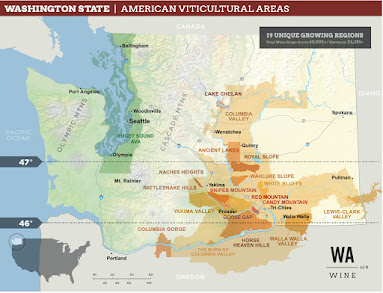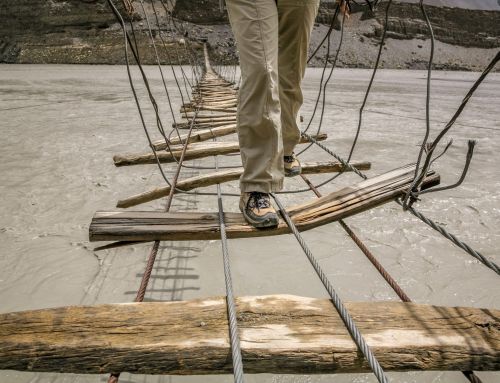
Washington is the wild west, with growers and vintners constantly exploring new varieties and new regions. The Burn of Columbia Valley, one of the state’s recently approved grapegrowing areas, is one such place.
While Dr. Walter Clore, the father of Washington wine, is said to have planted a test plot in The Burn decades ago, the appellation did not have its first commercial plantings until 2002, a scant few acres. Rather, almost all of its existing vineyard acreage has been planted in the last six years. This makes The Burn Washington’s youngest grapegrowing region. Despite its youth, Kevin Corliss, vice president of vineyards at Ste Michelle Wine Estates, says the area’s physical characteristics immediately differentiated it.
“Even before planting it, we knew that we were going to get different grapes from [The Burn],” he says. “As we’ve harvested from it for the last few years, they’re very, very different.”
Four primary factors differentiate The Burn as a growing region: soils, precipitation, heat accumulation, and wind.
In terms of soils, 80% of the plantable area is comprised of nine soil series, with the dominant one Walla Walla silt loam (30%). This is a slightly heavier soil type than much of the surrounding region.
“The soils are very different from what we would expect to see in that area,” says Joan Davenport, a professor of soil sciences at Washington State University who was contracted to write the appellation petition. “They’re higher in organic matter, which means they have more nutrient capacity, but they also have more water-holding capacity than so many of the soils we typically find in the majority of the Columbia Valley.” This second aspect factors into the area’s next defining feature: its above average precipitation.
The Burn receives an average of 8.76 inches of precipitation annually (range 6.65-10.44 inches). While this still makes it desert-dry, it’s above the mammoth Columbia Valley’s average of 6 to 8 inches per year (The Burn being a sub-appellation of Columbia Valley). In fact, it’s higher than the averages for other Columbia Valley sub-appellations with three exceptions: Columbia Gorge (10.4 inches with considerably more in the western sections), Lake Chelan (10.7), and Walla Walla Valley (18.4). The combination of heavier soils and increased rainfall impacts irrigation usage during the growing season.
“In The Burn, we’re usually a couple of weeks behind the [Horse Heaven Hills] starting water,” says Rob Mercer, owner of Mercer Wine Estates. “We also probably use two or three inches less water per year.”
The heavier soils also affect irrigation kinetics. “The soil actually holds the water instead of having it just flow right through,” says Corliss. “It’s a more gradual up and gradual down.”
The area’s heat accumulation is another defining factor. The Burn is warm, averaging 3306 Growing Degree Days annually over the last 10 years. This number has been exceeded only by Snipes Mountain and Wahluke Slope during that time. While one might think this would bring an opulent fruit profile, this is where the area’s final key factor – its persistent winds – play a strong role.
Horse Heaven Hills and its extension into Walla Walla Valley, Vansycle Ridge, are known for near-constant winds, so much so that the largest windfarm in the Pacific Northwest is located on the eastern section of this anticline. These winds help make Hood River, located in Columbia Gorge west of The Burn, a world-class wind surfing destination. The Burn, which lies between Horse Heaven Hills and Columbia Gorge, is no different in this respect, and a windfarm is located across the river from the appellation.
“The wind is just relentless,” Juan Muñoz-Oca, chief winemaker at Ste Michelle Wine Estates, says of The Burn.
As in other nearby appellations, the wind has an impact, slowing maturation and contributing to smaller canopy sizes and somewhat smaller berries. Taken together, all these aspects create The Burn’s unifying feature.
“It’s a warm site that acts more like a cool site,” says Corliss. “It’s a region that has a lot of heat units, but we pick it last.” This is particularly intriguing given the number of heat units and the fact that bud break begins early in the appellation.
“We have this long ripening period,” says Mercer. “We also have late frost, so we’re able to hang [fruit] longer.”
The vast majority of plantings in The Burn are red varieties (90%), with Cabernet Sauvignon far and away the most planted. Muñoz-Oca says the Cabernet Sauvignon from The Burn is distinctive.
“What we get is this Cabernet that is not afraid to show its herbaceousness, with a fantastic textural experience because the tannins are completely resolved. The Cabernets are nice, light on their feet, Old World style with the suppleness of the New World.”
Almost all of the fruit from The Burn currently goes to Ste Michelle Wine Estates for its Borne of Fire label, which was launched in 2017. Mercer Ranches, which farms the plantings in The Burn, uses some of the fruit for its wines as well.
The Burn is 16,870 total acres in size, with approximately 1,500 currently planted to grape vines – an astonishing number in just six years’ time. The appellation is comprised of four south-southeast facing benches with an average slope of seven percent. There are four commercial vineyards within the appellation, three of which are farmed by Mercer Ranches as well as a small site owned by Aanpama/Peggy Hoag.
Trail Blazer Vineyard is located on the first bench, closest to the Columbia River. Chapman Creek Vineyard is on the third bench. Old Highway 8 Vineyard is on the fourth and highest bench. The second bench has not yet been planted.
“Being a series of benches makes it interesting,” Davenport says of The Burn. “That’s very different from the other parts of the Columbia Valley.” Elevations in the appellation range from 270 to 1,780 feet above sea level.
Bounded by the Columbia River to the south, the area between Rock Creek and Chapman Creek has been referred to as The Burn since at least the early 1900s. The origins of the name are not known.
While Cabernet Sauvignon is the dominant variety, there are also plantings of Chardonnay, Malbec, Syrah, and a small amount of Sangiovese (three acres at Aanpama/Peggy Hoag planted in 2002 and 2013). Much of the Chardonnay is planted at Old Highway 8 Vineyard, the upper bench.
“It’s not as tropical as your typical [Washington] Chardonnay, even from the Horse Heaven Hills,” Muñoz-Oca says. “It’s a lot more citrusy.”
Though Ste Michelle Wine Estates currently receives almost all the fruit from The Burn, Muñoz-Oca hopes that changes.
“It’s kind of that idea of ‘If you build it they will come,” he says. “Hopefully [the approval of the appellation] will bring more people to the place, and we will start having a more diverse view of what the appellation has to offer. I truly believe that there is some uniqueness to The Burn.”









Leave A Comment